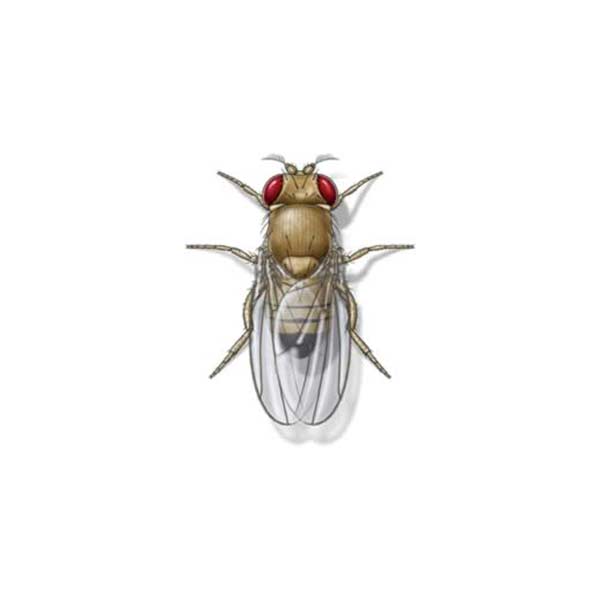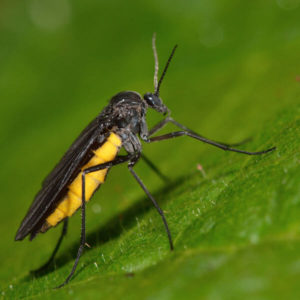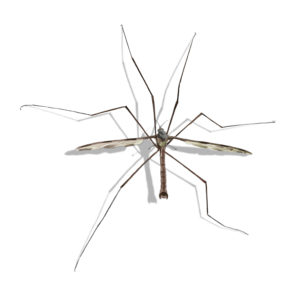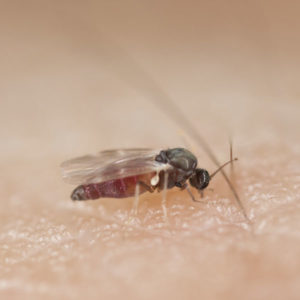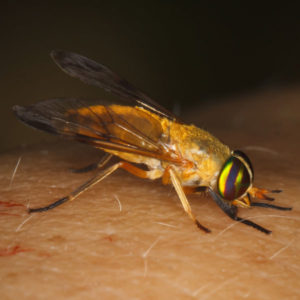Over 177 species of fruit flies occur in North America, north of Mexico, and eight species are believed to be common in the United States. The scientific name, Drosophila, means “lover of dew” probably suggesting these flies require moist environments to reproduce. They are known as fruit, vinegar, or pomace flies and are often confused with other small flies found in structures. Fruit flies are vectors of disease, consuming bacteria and sugar from decaying foods and can often be seen near bowls of fruit, glasses of wine, garbage, and trash cans. Unsure on the type of fly you are dealing with? Take a look at the most common flies found in North Carolina to help identify the specific fly species.
Fruit Fly Identification
What Do Fruit Flies Look Like?
Fruit flies are small, approximately 1/8 inch (3mm) in length, characterized by their distinctive red eyes, although some may have darker eyes. Their bodies are usually tan to yellowish in color, with translucent wings that may have a slight yellow or brown tinge. Under magnification, one can observe the unique pattern of veins in their wings, which is often used by entomologists for species identification.
Signs of a Fruit Fly Infestation
The most obvious sign of an infestation is the presence of adult fruit flies buzzing around food sources or garbage areas. Additional indicators include:
- Larvae (maggots) in moist, fermenting foodstuffs or organic material.
- Pupae, which may be found near breeding sites, indicating a breeding population.
- Increased activity around sinks, drains, and trash cans, where they find food and breeding grounds.
Habitat, Diet, Life Cycle & Bites
Where Do Fruit Flies Live?
Fruit flies are small flies that can pass through ordinary insect screens and are often found in homes, restaurants, fruit markets, bars, salad bars, and any other place where fruits and vegetables are found. They will often enter structures from nearby dumpsters, trash receptacles, and damp compost piles where fruits and vegetables have been disposed of. Fruit flies lay large numbers of eggs on fruit, and the hatched larvae feed on the fruit. Fruit flies are active during periods of warm weather; single generations may develop in less than a week when temperatures are between 80° and 89°F. Indoors, they are commonly found in kitchens, near garbage storage areas, and anywhere food is processed or stored. Outdoors, they live in areas where rotting fruit and vegetables are present.
Diet of a Fruit Fly
Fruit flies feed on yeast organisms and fungi that grow on rotting fruit and fermenting materials. This diet is why they are attracted to overripe fruits, spilled wine, beer, and other sugary, fermented beverages.
Life Cycle of a Fruit Fly
The life cycle of a fruit fly is remarkably quick, allowing populations to explode in a short period under favorable conditions. Females lay eggs on the surface of fermenting foods or organic materials. These eggs hatch into larvae, which feed on the surface of these materials. Within a week, they complete their development through the larval and pupal stages, emerging as adults ready to reproduce. The entire cycle from egg to adult can occur in as little as a week in warm conditions.
Fruit Fly Bites
Unlike some insects, fruit flies do not sting or bite.Their mouthparts are not designed to pierce skin; instead, they are adapted for sponging up the surface of their food sources.
Are Fruit Flies Dangerous?
They are primarily nuisance pests, however, results of a recent study showed that fruit flies are capable of transferring E.coli, Salmonella, and Listeria to surfaces and relocating E.coli from a contaminated source to fresh, ready-to-eat food. Although fruit flies spend the majority of their time fermenting foods, they also travel to dishes, flatware, drinking glasses, and even toothbrushes. While you may not consume the contaminated produce itself, when you eat or drink from these objects, you’re exposed to the same bacteria the fruit fly has transported from site to site.
How to Get Rid of Fruit Flies?
Effective fruit fly management combines immediate measures to reduce adult populations with strategies to eliminate breeding sites.
- Sanitation: This is the cornerstone of fruit fly management. Regularly remove garbage, clean spills immediately, and store fruit and vegetables in the refrigerator or sealed containers.
- Exclusion: Repair screens on windows and doors to prevent outdoor fruit flies from entering. Seal cracks and crevices where fruit flies can enter the home or breed.
- Traps: A variety of DIY and commercial traps can be effective in capturing adult fruit flies. Common homemade traps include bowls of vinegar or wine covered with plastic wrap poked with small holes. If you are dealing with a persistent fruit fly problem on your property, contact your local fly exterminators.
Fruit Fly Prevention Tips
Preventative measures can significantly reduce the likelihood of fruit fly infestations.
- Fruit Storage: Store ripe fruit in the refrigerator and inspect fruits and vegetables for signs of damage before purchasing.
- Waste Management: Dispose of food waste in a timely manner and use a compost bin with a tight-fitting lid if composting organic material.
- Drain Maintenance: Regularly clean drains and use drain gels or cleaners to remove organic material where fruit flies may breed.
Need help with Fruit Flies control?
FAQs
What Causes Sudden Fruit Flies?
A sudden appearance of fruit flies is often due to introduced fermenting materials such as overripe fruit, decaying vegetables, or spilled sugary liquids that have not been cleaned up. They can also come from grocery store produce that was already infested.
Where Do Fruit Flies Lay Eggs in the House?
Fruit flies lay eggs in moist areas with organic material for the larvae to feed upon. This includes the surface of overripe fruit, inside garbage disposals, on dirty dishes, and in mops or cleaning rags that have not been properly dried.

